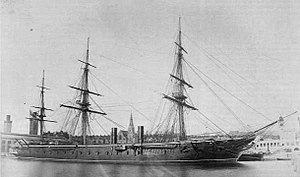Warrior-class ironclad

HMS Warrior in the 1860s
|
|
| Class overview | |
|---|---|
| Name: | Warrior-class ironclad |
| Operators: |
|
| Preceded by: | None |
| Succeeded by: | Defence class |
| Built: | 1859–62 |
| In service: | 1861–1979 |
| In commission: | 1861–1902 |
| Completed: | 2 |
| Scrapped: | 1 |
| Preserved: | 1 |
| General characteristics (Warrior as built) | |
| Type: | Armoured frigate |
| Displacement: | 9,137 long tons (9,284 t) |
| Length: | 420 ft (128.0 m) |
| Beam: | 58 ft 4 in (17.8 m) |
| Draught: | 26 ft 10 in (8.2 m) |
| Installed power: | 5,267 ihp (3,928 kW) |
| Propulsion: | 1 shaft, 1 Trunk steam engine |
| Sail plan: | Ship rig |
| Speed: | 14 knots (26 km/h; 16 mph) |
| Range: | 2,100 nmi (3,900 km; 2,400 mi) at 11 kn (20 km/h; 13 mph) |
| Complement: | 707 |
| Armament: |
|
| Armour: | |
The Warrior-class ironclads were a class of two warships built for the Royal Navy between 1859 and 1862, the first ocean-going ironclads with iron hulls ever constructed. The ships were designed as armoured frigates in response to an invasion scare sparked by the launch of the French ironclad Gloire and her three sisters in 1858. They were initially armed with a mix of rifled breech-loading and muzzle-loading smoothbore guns, but the Armstrong breech-loading guns proved unreliable and were ultimately withdrawn from service.
The ships spent their first commission with the Channel Fleet before being rearmed with new rifled muzzle-loading guns in the late 1860s. Warrior rejoined the Channel Fleet after her refit while Black Prince joined the 1st Class Reserve and joined the fleet during its annual manoeuvres. The two ships exchanged roles after another refit in the mid-1870s. Both ships spent most of the last two decades of the 19th century in . Warrior was hulked in 1902 and survived to be restored in 1979 as a museum ship. Black Prince became a training ship in 1896 and was hulked in 1910 before being sold for scrap in 1923.
The Warrior-class ships have been described as revolutionary, but in truth they were more evolutionary than not as everything except their wrought iron armour had been in use by ocean-going ships for years. The naval architect and historian David K. Brown commented, "What made [Warrior] truly novel was the way in which these individual aspects were blended together, making her the biggest and most powerful warship in the world." They were designed in response to Gloire, which started an invasion scare in Britain, but they had a very different concept of operation to the French ship which was meant as a replacement for wooden ships of the line. They were designed by Chief Constructor of the Navy Isaac Watts as 40-gun armoured frigates largely based on the fine lines of the large frigate Mersey. Warrior and her sister Black Prince were not intended to stand in the line of battle as the Admiralty was uncertain about their ability to withstand concentrated fire from wooden two and three-deck ships of the line. Rather they were designed to be fast enough to force battle on a fleeing enemy and to control the range at which a battle was fought for their own advantage.
...
Wikipedia
